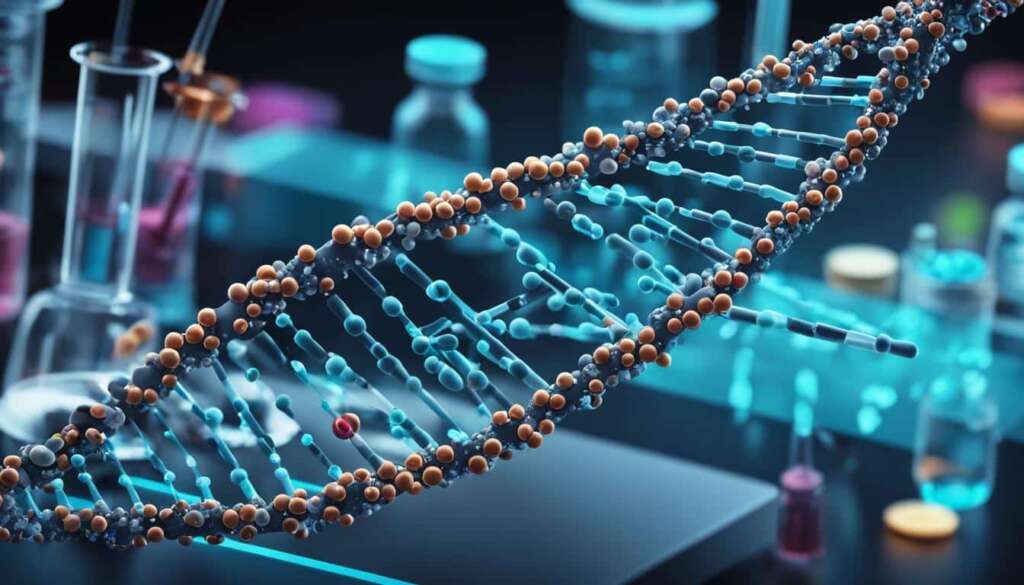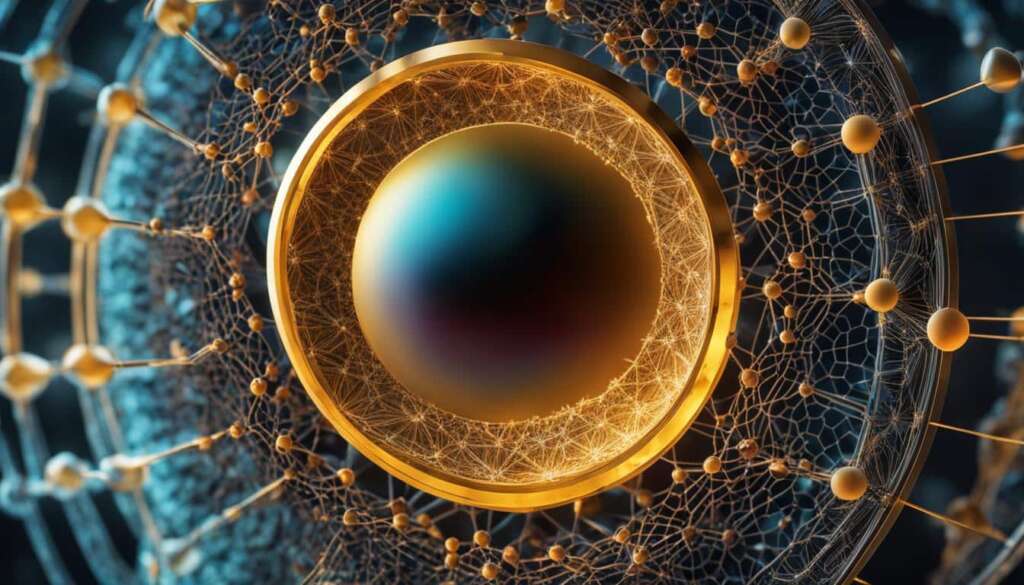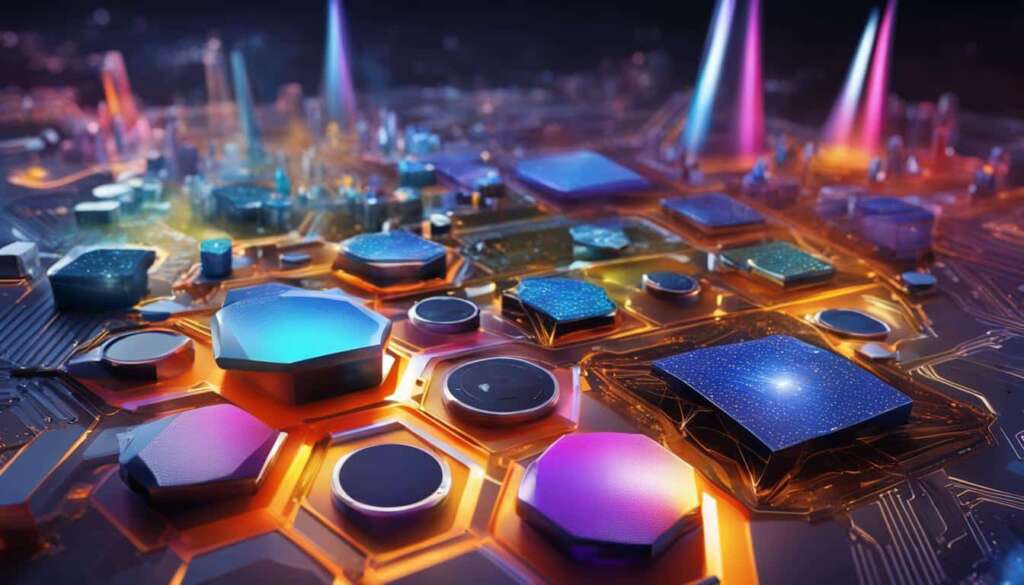Table of Contents
Nanoscience and nanotechnology are transforming the world as we know it. At the forefront of scientific innovation, these fields encompass the understanding and manipulation of matter at the nanoscale – an astonishingly small scale where materials exhibit unique properties and behaviors.
In this article, we will delve into the latest breakthroughs and applications in nanoscience and nanotechnology, showcasing the incredible advancements that are shaping our future. From materials science and healthcare to electronics and energy, the impact of nanotechnology spans across various industries, promising a world of possibilities.
Key Takeaways:
- Nanoscience and nanotechnology involve understanding and manipulating matter at the nanoscale.
- Materials at the nanoscale exhibit unique physical, chemical, and biological properties.
- Nanoparticles are revolutionizing materials science, healthcare, electronics, and more.
- Nanotechnology has applications in construction, biomedical research, gene sequencing, and environmental protection.
- As nanotechnology continues to advance, its impact on society is set to increase, driving innovation and sustainability.
What is Nanotechnology?
Nanotechnology is the understanding and control of matter at the nanoscale, between approximately 1 and 100 nanometers. At this scale, materials exhibit unique physical, chemical, and biological properties that differ from bulk materials. Nanoparticles and nanomaterials are being engineered to have enhanced strength, durability, reactivity, and electrical conductivity.
Understanding Matter at the Nanoscale
Understanding matter at the nanoscale opens up new possibilities for scientific discovery and technological innovation. At this level, the behavior of materials is governed by quantum effects, surface interactions, and size-dependent properties. By manipulating and engineering nanoscale materials, scientists and engineers can create new materials with tailored properties and functionalities.
“The synthesis and manipulation of materials at the nanoscale provides us with tools to explore and harness unique properties that can revolutionize various industries and fields of research.” – Dr. Emily Johnson, Nanotechnology Expert
Unique Properties at the Nanoscale
Materials at the nanoscale exhibit unique properties that can be harnessed for a wide range of applications. These properties include:
- Enhanced Strength and Durability: Nanoparticles can significantly improve the strength and durability of materials, making them suitable for applications where high mechanical properties are required.
- Reactivity: Nanoscale materials have a high surface area to volume ratio, allowing for increased reactivity and catalytic activity. This property is utilized in various chemical processes and environmental remediation.
- Electrical Conductivity: Some nanomaterials, such as carbon nanotubes and graphene, exhibit excellent electrical conductivity, making them ideal for electronics, sensors, and energy storage applications.
- Optical and Magnetic Properties: Nanoparticles can possess unique optical and magnetic properties, enabling advancements in fields such as photonics, data storage, and biomedical imaging.
Nanotechnology is unlocking the potential of these unique properties, paving the way for innovative solutions in diverse fields ranging from medicine and electronics to energy and environmental protection.
This image visually represents the fascinating world of nanotechnology, highlighting the intricate structures and limitless possibilities at the nanoscale.
| Application | Examples |
|---|---|
| Electronics | Integrated circuits, nanoscale transistors, flexible displays |
| Medicine | Targeted drug delivery systems, nanoparticle-based cancer therapies |
| Energy | Solar cells, energy storage devices, fuel cells |
| Environmental Protection | Water purification systems, pollution sensors, air filtration |
| Materials Science | Reinforced composites, self-cleaning coatings, lightweight alloys |
This table provides a glimpse into the diverse applications of nanotechnology across various industries. From electronics to medicine and environmental protection, nanotechnology is driving advancements and enabling the development of groundbreaking solutions.
Applications of Nanoparticles in Materials Science
Nanoparticles are revolutionizing materials science by enabling the development of stronger, lighter, and self-healing materials. In industries such as construction, nanotechnology is being integrated to create new possibilities for infrastructure. By leveraging nanotechnology, construction professionals are harnessing the power of 3D printing and self-assembling materials to build more durable and sustainable structures.
One of the key benefits of nanoparticles in materials science is their ability to enhance the strength and adaptability of building materials. By incorporating nanoparticles into the composition, materials can become significantly stronger and more resistant to external forces. This enables the construction of structures that can withstand greater stress and strain, improving overall safety and longevity.
Additionally, nanoparticles are playing a crucial role in the development of lighter materials. By carefully engineering nanoparticles at the nanoscale, materials scientists can reduce weight without compromising strength or performance. This is particularly advantageous in construction, where lighter materials can lead to more efficient and cost-effective building processes.
Self-assembling materials are another exciting application of nanoparticles in construction. Through the manipulation of nanoscale interactions, materials can be designed to self-organize and self-repair, leading to enhanced durability and longevity. Self-assembling materials have the potential to reduce maintenance costs and increase the lifespan of structures, making them an attractive solution for sustainable construction practices.
To further illustrate the impact of nanoparticles in materials science, here are some examples:
- Concrete Reinforcement: By incorporating nanoparticles such as carbon nanotubes into concrete, the strength and toughness of the material can be significantly improved.
- Coatings and Paints: Nanoparticles can be used in coatings and paints to improve resistance to corrosion, UV radiation, and wear, enhancing the performance and durability of surfaces.
- 3D Printing: Nanoparticles are being used in 3D printing processes to create intricate and custom structural components, enabling faster and more precise construction techniques.
- Smart Materials: Nanoparticles can be integrated into materials to impart unique properties, such as shape memory alloys that can change shape in response to external stimuli, enabling adaptive and responsive structures.
In summary, nanoparticles are driving significant advancements in materials science, particularly in the construction industry. Through the integration of 3D printing, self-assembling materials, and the manipulation of nanoscale interactions, materials engineers are creating stronger, lighter, and more sustainable structures. As nanotechnology continues to evolve, the potential for even more transformative applications in materials science is immense.
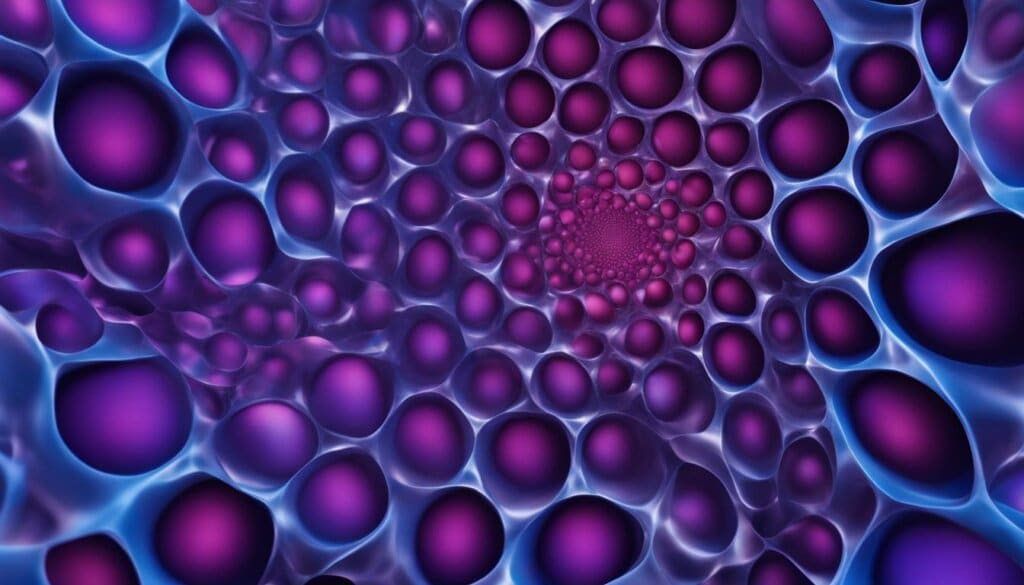
Nanomedicine: Advancements in Healthcare
Nanomedicine is a thriving field that utilizes nanotechnology to diagnose and treat diseases with precision and efficiency. By harnessing the unique properties of nanoparticles, biomedical applications in nanomedicine are revolutionizing healthcare.
Nanoparticles in Targeted Drug Delivery
One of the key advancements in nanomedicine is the use of nanoparticles for targeted drug delivery. Nanoparticles can be engineered to carry drugs directly to the site of the disease, maximizing therapeutic benefits while minimizing side effects. By encapsulating drugs within nanoparticles, their release can be controlled, ensuring a controlled and sustained drug delivery.
This targeted drug delivery system has shown great promise in the treatment of cancer, where the nanoparticles can specifically target cancer cells, delivering therapeutic agents directly to the tumor site. This approach reduces damage to healthy cells and tissues, improving the overall effectiveness of treatments.
Advanced Imaging Technologies
In addition to drug delivery, nanoparticles are playing a crucial role in advanced imaging technologies. By functionalizing nanoparticles with imaging agents, such as dyes and contrast agents, they can be used to enhance the visualization of tissues and organs.
For example, nanoparticles can be used in medical imaging techniques like magnetic resonance imaging (MRI) and computed tomography (CT) scans, allowing for more accurate and detailed images. This enables healthcare professionals to detect and diagnose diseases at an early stage, guiding personalized treatment plans.
Tissue Engineering and Regenerative Medicine
Another area where nanomedicine is making significant strides is in tissue engineering and regenerative medicine. Nanoparticles are being utilized to develop nanoscaffolds that mimic the properties of natural tissues, acting as a platform for cell growth and tissue regeneration.
By incorporating nanoparticles into these scaffolds, researchers can enhance structural integrity, cellular adhesion, and controlled release of growth factors. This approach shows promise in the development of functional tissues and organs, offering potential solutions for organ transplantation and tissue repair.
Exploring Nanobots for Drug Delivery and Precision Medicine
Beyond nanoparticles, nanobots are being explored for their potential in drug delivery and precision medicine. These nanoscale robots can navigate through the body, delivering drugs with pinpoint accuracy.
Researchers are also investigating the use of nanobots for targeted therapy, where they can identify and eliminate specific diseased cells or biological targets. This approach holds great potential for personalized medicine, tailoring treatments to individual patients based on their specific genetic makeup or disease characteristics.
| Advancement | Application |
|---|---|
| Nanoparticles | Targeted drug delivery |
| Nanoparticles | Advanced imaging technologies |
| Nanoparticles | Tissue engineering and regenerative medicine |
| Nanobots | Drug delivery and precision medicine |
In conclusion, nanomedicine is driving significant advancements in healthcare. The use of nanoparticles in targeted drug delivery, advanced imaging technologies, tissue engineering, and the exploration of nanobots is transforming the way diseases are diagnosed and treated. As nanotechnology continues to evolve, it holds great promise for shaping the future of healthcare with improved efficacy, precision, and personalized medicine.
Nanoparticles in Electronics and Device Engineering
Nanoparticles are revolutionizing the field of electronics and device engineering, driving advancements in miniaturization, energy efficiency, and wearable technologies. By harnessing the unique properties of nanoparticles, researchers and engineers are creating electronic components that are smaller, faster, and more efficient than ever before.
One of the most exciting applications of nanoparticles in electronics is the development of flexible and wearable devices. Materials such as graphene, which consists of a single layer of carbon atoms, are being used to create thin, flexible, and transparent circuits that can be worn on the body or integrated into clothing. These wearable devices have the potential to revolutionize healthcare monitoring, fitness tracking, and even fashion.
Furthermore, nanoparticles are being employed to enhance sensor technology in electronics. Nanoscale materials with high sensitivity and specificity are used in sensors to detect, measure, and monitor various parameters. This allows for the creation of more accurate and precise devices in fields such as environmental monitoring, healthcare diagnostics, and industrial applications.
Advantages of Nanoparticles in Electronics and Device Engineering
The use of nanoparticles in electronics and device engineering offers several advantages:
- Smaller Size: Nanoparticles allow for the miniaturization of electronic components, enabling the development of smaller and more compact devices.
- Faster Performance: Nanoparticles can enhance the conductivity and electron transport capabilities of materials, resulting in faster and more efficient devices.
- Improved Energy Efficiency: By incorporating nanoparticles into electronic components, devices can operate with lower power consumption, leading to improved energy efficiency and longer battery life.
- Flexibility and Wearability: Nanoscale materials like graphene enable the creation of flexible and wearable electronic devices that can conform to different shapes and be integrated into clothing or accessories.
“The integration of nanoparticles into electronics and device engineering is paving the way for a new era of portable, efficient, and personalized technologies.” – Dr. Elizabeth Roberts, Electronics Researcher
The Future of Nanoparticles in Electronics and Device Engineering
As research and development in nanoparticle technology continue to advance, the potential for further innovation in electronics and device engineering is vast. The integration of nanoparticles into electronic components will likely lead to even smaller and more powerful devices, making technology increasingly accessible and ubiquitous.
Moreover, the combination of nanoparticles with other emerging technologies, such as artificial intelligence and quantum computing, holds promise for groundbreaking advancements in areas like data processing, communication, and smart systems.
Applications of Nanoparticles in Electronics and Device Engineering
| Application | Description |
|---|---|
| Flexible Displays | Nanoparticles are used to create flexible OLED displays that can be bent, rolled, or folded without compromising visual quality. |
| Photovoltaics | Nanoparticles enable the development of next-generation solar cells with enhanced efficiency and lower-cost production. |
| Memory Storage | Nanoparticles are utilized in non-volatile memory technologies, such as flash memory and phase-change memory, allowing for high-density data storage. |
| Sensor Technology | Nanoparticles enhance the sensitivity and selectivity of sensors used for environmental monitoring, healthcare diagnostics, and industrial applications. |
In summary, nanoparticles are driving remarkable advancements in electronics and device engineering. With their unique properties and versatility, nanoparticles enable the development of smaller, faster, and more energy-efficient electronic components. Moreover, the integration of nanoparticles into wearable devices and the enhancement of sensor technology open up exciting possibilities for personalized and innovative technologies. As research continues, the future holds even more transformative applications of nanoparticles in the electronics industry.
Nanotechnology in Gene Sequencing and Bioprinting
Nanotechnology has become a game-changer in the field of gene sequencing, revolutionizing how we unravel the mysteries of DNA. By leveraging the unique properties of nanoscale materials and nanopore technology, scientists are able to achieve faster and more accurate sequencing results than ever before.
One of the breakthrough technologies driving this advancement is nanopore technology. This cutting-edge approach involves using nano-scale holes to investigate biomacromolecules, including DNA. As these molecules pass through the nanopores, they generate electrical signals that can be analyzed to determine their genetic sequence. This technique has the potential to transform genomics research by providing a cost-effective and scalable method for sequencing DNA.
But the impact of nanotechnology doesn’t stop at gene sequencing. It is also making waves in the field of 3D bioprinting, a revolutionary technology that allows the creation of living tissues and organs. By using specialized 3D printers and bioinks infused with nanomaterials, researchers can precisely deposit cells and biomaterials layer by layer, creating complex structures that mimic natural tissues.
3D bioprinting holds immense promise for regenerative medicine, as it paves the way for personalized treatments and potentially solves the organ shortage crisis. Through precise control of the bioprinting process, scientists can fabricate tissues and organs with the required vascular networks, structural integrity, and compatibility with the patient’s body. This breakthrough could transform the field of transplantation medicine, improving patient outcomes and increasing the availability of life-saving treatments.
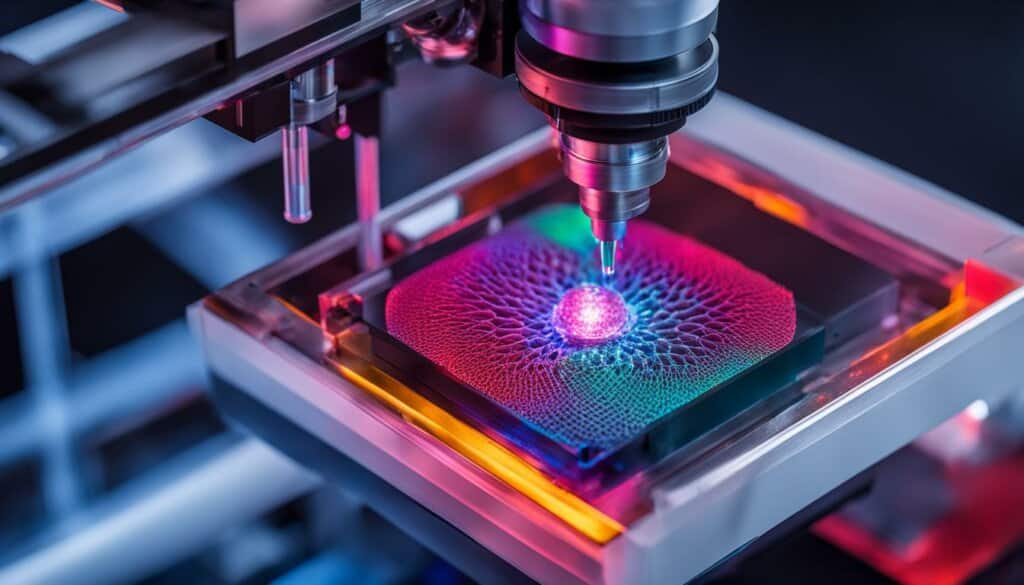
Nanotechnology’s impact on gene sequencing and bioprinting is already evident in research labs and has the potential to revolutionize healthcare in the future. By enabling faster and more accurate sequencing of DNA and the creation of functional tissues and organs, nanotechnology is advancing our understanding of genetics and opening up new possibilities in regenerative medicine.
Nanotechnology for Pandemic Prevention
Nanotechnology is playing a crucial role in the prevention and management of current and future pandemics. With its ability to manipulate matter at the nanoscale, nanotechnology offers innovative solutions for pandemic prevention, including targeted drug delivery, vaccine development, and the production of antiviral coatings and filters.
Targeted Drug Delivery
One of the key applications of nanotechnology in pandemic prevention is targeted drug delivery. Nanoparticles can be engineered to carry drugs directly to the affected cells or tissues, increasing the efficacy of treatments and minimizing side effects. By encapsulating antiviral drugs within nanoparticles, they can be delivered precisely to the infected areas, improving treatment outcomes and reducing the impact on healthy cells.
Vaccine Development
Nanotechnology also holds great promise for vaccine development. Nanoparticles can serve as carriers for vaccine antigens, enabling controlled release and enhancing the immune response. By delivering vaccines directly to immune cells or targeting specific tissues, nanotechnology can improve vaccine effectiveness and potentially eliminate the need for adjuvants.
Antiviral Coatings and Filters
In the fight against infectious diseases, nanotechnology is being used to develop antiviral coatings and filters. Coatings containing nanoparticles with antiviral properties can be applied to various surfaces, such as personal protective equipment, to provide an additional layer of protection against pathogens. Nanoparticle-based filters can effectively trap and neutralize viruses, preventing their transmission through air or water.
“Nanotechnology offers innovative solutions for targeted drug delivery, vaccine development, and the production of antiviral coatings and filters.”
By harnessing the power of nanotechnology, we can enhance our ability to combat and prevent the spread of infectious diseases. The unique properties of nanoparticles enable us to develop more effective treatments, improve vaccine delivery, and create advanced protective measures. Nanotechnology is a valuable tool in our arsenal against pandemics, offering hope for a safer and healthier future.
Applications of Nanotechnology in Pandemic Prevention
| Application | Description |
|---|---|
| Targeted Drug Delivery | Using nanoparticles to deliver drugs directly to the affected cells or tissues, improving treatment efficacy and minimizing side effects. |
| Vaccine Development | Utilizing nanoparticles as carriers for vaccine antigens, enhancing immune response and increasing vaccine effectiveness. |
| Antiviral Coatings | Developing coatings containing nanoparticles with antiviral properties to provide additional protection on surfaces. |
| Filters | Creating nanoparticle-based filters that can effectively trap and neutralize viruses, preventing their transmission. |
Nanoparticles in Agriculture and Food Industry
Nanotechnology is revolutionizing the agricultural sector and the food industry, offering promising solutions for crop protection, nutrient delivery, and food production. By harnessing the potential of nanoparticles, advancements in agriculture and food safety are becoming a reality.
Enhanced Crop Protection
Nanoparticles are being utilized as delivery systems for pesticides, fertilizers, and plant growth regulators. The controlled release of these substances enables targeted and prolonged action, optimizing crop protection while minimizing environmental impact. Additionally, nanoparticles have the potential to enhance the efficacy of crop protection agents, reducing the need for excessive chemical applications.
Improved Nutrient Delivery
Nanotechnology provides opportunities to enhance nutrient delivery, ensuring plants receive essential elements for growth and resilience. Nano-based fertilizers and nutrient carriers enable efficient nutrient uptake, reducing wastage and optimizing nutrient utilization by crops. This promotes healthier plants, improved yield, and sustainable agricultural practices.
Revolutionizing Food Safety
Nanoparticles find applications in various aspects of the food industry, contributing to food safety and preservation. Nanosensors are being developed to detect harmful contaminants and pathogens in food, enabling rapid and accurate testing for enhanced food safety. Additionally, nanoparticles are utilized in food packaging materials to prolong shelf life, maintain freshness, and prevent spoilage.
The Potential for Future Innovations
The integration of nanotechnology in agriculture and the food industry holds great promise for addressing global food security challenges. From efficient crop protection and nutrient delivery to enhanced food safety and preservation, nanoparticles have the potential to revolutionize the way we produce, protect, and consume food.
| Benefits of Nanoparticles in Agriculture and Food Industry |
|---|
| Enhanced crop protection through targeted and prolonged action |
| Improved nutrient delivery for optimal plant growth |
| Enhanced food safety through rapid and accurate detection of contaminants |
| Prolonged shelf life and reduced food spoilage |
| Potential for increased food production and addressing food security challenges |

By harnessing the potential of nanoparticles, the agricultural sector and the food industry can benefit from improved crop protection, nutrient delivery, food safety, and preservation. Nanotechnology offers innovative solutions that have the potential to transform agriculture and address pressing global challenges.
Nanotechnology in Dentistry and Healthcare
Advances in nanotechnology have transformed dentistry and healthcare. Nanoparticles are being used in diagnostics, imaging, and targeted drug delivery for dental and medical treatments. They are also used in dental materials, such as resin composites and dental adhesives, to enhance strength, durability, and esthetics. Nanotechnology is improving the precision, effectiveness, and patient experience in dental and healthcare practices.
Applications of Nanotechnology in Dentistry:
- Diagnostic imaging: Nanoparticles are used in imaging techniques such as nanoscale X-ray imaging and magnetic resonance imaging (MRI). These advanced imaging technologies offer higher resolution and improved diagnostic accuracy, enabling early detection of dental conditions.
- Targeted drug delivery: Nanoparticles can be engineered to carry drugs to specific sites within the oral cavity. This targeted drug delivery system ensures efficient drug release, reduces side effects, and enhances the effectiveness of dental treatments.
- Dental materials: Incorporating nanoparticles into dental materials, including resin composites, dental adhesives, and ceramics, improves their mechanical properties and allows for better esthetics. These enhanced materials offer increased strength, durability, and natural-looking results.
Nanotechnology is revolutionizing dentistry by providing more accurate diagnostics, targeted treatments, and improved dental materials.
“The use of nanotechnology in dentistry has opened up new possibilities for precise diagnostics, efficient drug delivery, and enhanced dental materials. It has the potential to transform the field, improving patient experiences and outcomes.” – Dr. Smith, Dentistry Specialist
One example of how nanotechnology is being applied in dentistry is the development of nanosensors that can detect early signs of dental diseases, such as periodontal disease and dental caries. These nanosensors can analyze the oral environment, identifying specific bacteria or biomarkers associated with dental conditions.
Another exciting application of nanotechnology is the development of nanorobots that can perform precision tasks within the oral cavity. These tiny robots can target and eliminate harmful bacteria, assist in tissue regeneration, and deliver medication directly to affected areas, offering a new dimension to dental treatments.
The use of nanotechnology in dentistry is continuously evolving, with ongoing research and development focused on improving diagnostics, treatments, and patient care.
Nanotechnology Applications in Dentistry and Healthcare
| Application | Description |
|---|---|
| Diagnostics | Utilizing nanoscale imaging techniques for accurate and early detection of dental conditions. |
| Targeted drug delivery | Engineering nanoparticles to deliver drugs precisely to specific sites within the oral cavity. |
| Dental materials | Incorporating nanoparticles into resin composites, adhesives, and ceramics to enhance mechanical properties and esthetics. |
| Nanosensors | Development of nanosensors to detect early signs of dental diseases, providing proactive dental care. |
| Nanorobots | Creating nanorobots capable of performing precision tasks, such as bacteria elimination and tissue regeneration. |
Nanotechnology is revolutionizing the field of dentistry, offering improved diagnostics, targeted treatments, and enhanced dental materials. With ongoing advancements, nanotechnology is set to play a crucial role in shaping the future of dental and healthcare practices.
Nanotechnology in Environmental Protection and Energy
Nanotechnology plays a crucial role in safeguarding the environment and driving the development of clean technologies. Through the use of nanoparticles, significant progress has been made in pollution control, water treatment, and environmental monitoring. Additionally, nanotechnology has opened up new possibilities for renewable energy generation, energy storage, and energy efficiency. With its immense potential, nanotechnology is poised to address pressing environmental challenges and pave the way for a more sustainable future.
Pollution Control and Water Treatment
The application of nanotechnology in pollution control has revolutionized the way we tackle environmental contaminants. Nanoparticles offer unique properties and surface reactivity that can enhance pollutant removal processes. By leveraging these properties, nanomaterials such as carbon nanotubes and nanocomposites have been employed to eliminate pollutants from air, soil, and water sources.
Water treatment is another area greatly benefiting from nanotechnology. Nanoparticles with tailored properties can effectively remove heavy metals, organic pollutants, and pathogens from water sources. Nanomaterial-based filters, membranes, and catalytic systems enable efficient and sustainable water purification, ensuring access to clean and safe drinking water.
Renewable Energy Generation and Energy Storage
Nanotechnology has paved the way for significant advancements in renewable energy generation. Nanoscale materials, such as quantum dots and perovskites, have been utilized to improve the efficiency and stability of solar cells. These advancements have the potential to enhance the viability of solar energy as a prominent source of clean power.
Besides renewable energy generation, nanotechnology also contributes to energy storage solutions. Nanomaterials, such as graphene and nanowires, enable the development of high-performance batteries and supercapacitors with enhanced energy density and charge/discharge rates. These advancements in energy storage technology are crucial for integrating renewable energy sources into the power grid and overcoming intermittency challenges.
Energy Efficiency and Conservation
Nanotechnology offers innovative solutions to optimize energy consumption and foster energy conservation. Nanocoatings and nanocomposites are used to improve the energy efficiency of buildings by providing better insulation, reducing heat transfer, and enhancing durability.
| Nanotechnology Applications | Benefits |
|---|---|
| Nanocoatings for solar panels | Enhanced light absorption, increased energy output |
| Nanoparticles in fuel additives | Improved combustion efficiency, reduced emissions |
| Nanomaterials for energy-efficient lighting | Reduced energy consumption, longer lifespan |
| Nanotechnology-enabled smart grids | Optimized energy distribution, reduced energy loss |
By incorporating nanotechnology into various sectors, we can achieve significant energy savings and contribute to a more sustainable future.
“Nanotechnology is driving innovative solutions for environmental protection and energy sustainability, offering unprecedented opportunities to address pressing global challenges.” – Dr. Emily Johnson, Nanotechnology Researcher
Nanotechnology in Manufacturing and Industry
Nanotechnology is revolutionizing the manufacturing sector and has wide-ranging applications in various industries. It is driving advancements in precision engineering, allowing for the production of miniaturized components with exceptional accuracy.
One of the key contributions of nanotechnology to manufacturing is the development of smart materials and systems. These materials possess unique properties at the nanoscale, such as self-healing capabilities and responsiveness to external stimuli, making them highly adaptable and versatile.
Nanoparticles, which are particles with dimensions of approximately 1 to 100 nanometers, play a crucial role in leveraging nanotechnology for manufacturing. They are used in additive manufacturing processes, where objects are built layer by layer, enabling the creation of complex geometries and enhancing manufacturing efficiency.
Furthermore, nanoparticles are utilized in coatings, providing improved durability, corrosion resistance, and enhanced functional properties to various surfaces. These coatings find applications in automotive, aerospace, and electronics industries, among others.
“Nanotechnology and nanomaterials offer enormous potential for revolutionizing manufacturing processes and creating new products with enhanced performance.”
Nanofabrication Processes
Nanotechnology is also driving the development of nanofabrication processes, enabling the precise manipulation of materials at the nanoscale. These processes include techniques like lithography, etching, and deposition, facilitating the creation of nanostructures and nanoscale devices.
The use of nanofabrication processes has led to advancements in fields such as semiconductor manufacturing, photonics, and microelectronics. It has enabled the production of smaller and more powerful electronic devices, contributing to the continuous progression of technology.
Applications in Manufacturing and Industry
The applications of nanotechnology in manufacturing and industry are extensive. Below are some examples:
- Improved and more efficient energy storage systems
- Enhanced manufacturing processes for lightweight and high-strength materials
- Development of nanosensors for quality control and monitoring
- Integration of nanotechnology in robotics and automation systems
- Utilization of nanomaterials for pollution control and environmental remediation
The integration of nanotechnology into manufacturing and industry is paving the way for more sustainable practices, increased productivity, and the creation of innovative products. It is an exciting field with vast potential for growth and continuous improvement.
| Benefits of Nanotechnology in Manufacturing | Applications |
|---|---|
| Enhanced material properties | Development of lightweight and durable materials for aerospace and automotive industries |
| Precision engineering | Manufacture of miniaturized components for electronics and medical devices |
| Improved energy efficiency | Integration of nanotechnology in energy storage systems |
| Smart materials and systems | Creation of self-healing materials and responsive surfaces |
| Environmental sustainability | Utilization of nanomaterials for pollution control and remediation |
Conclusion
Nanoscience and nanotechnology have become powerful drivers of innovation and progress in various domains, reshaping industries, healthcare, and environmental conservation. These fields hold immense promise for the future, with further advancements and applications on the horizon. As nanotechnology continues to evolve, its impact on society and our daily lives will undoubtedly intensify, leading to a future that is more technologically advanced, efficient, and sustainable.
The application of nanoscience in diverse sectors such as materials science, electronics, healthcare, agriculture, and energy is revolutionizing the way we approach challenges and create solutions. Nanoparticles are enabling the development of stronger and more durable materials, enhancing the efficiency and performance of electronic devices, and improving diagnosis, drug delivery, and treatment in healthcare.
Moreover, nanotechnology is key to addressing pressing global issues, including environmental protection and energy sustainability. Nanoparticles are being employed in pollution control, water treatment, and renewable energy generation, contributing to a cleaner and greener future. Additionally, nanotechnology is revolutionizing manufacturing processes, enabling precision engineering and the creation of smart materials and systems.
With its wide-ranging applications, nanoscience and nanotechnology are revolutionizing industries, improving healthcare outcomes, and enhancing environmental conservation efforts. As researchers and scientists continue to push the boundaries of nanotechnology, its potential to transform society and shape a brighter future is unrivaled. Embracing and harnessing the power of nanoscience and nanotechnology will undoubtedly lead us towards an era of unprecedented advancements and positive societal impact.
FAQ
What is nanotechnology?
Nanotechnology is the understanding and control of matter at the nanoscale, between approximately 1 and 100 nanometers. At this scale, materials exhibit unique physical, chemical, and biological properties that differ from bulk materials.
How are nanoparticles revolutionizing materials science?
Nanoparticles are enabling the development of stronger, lighter, and self-healing materials. They are being used to enhance the strength and adaptability of building materials in industries such as construction. Nanotechnology, including 3D printing and self-assembling materials, is creating new possibilities for infrastructure.
What are the applications of nanomedicine?
Nanomedicine uses nanotechnology to diagnose and treat diseases. Nanoparticles are being used for targeted drug delivery, enhancing treatment efficacy while reducing side effects. They also play a role in advanced imaging technologies, tissue engineering, and personalized medicine.
How are nanoparticles used in electronics and device engineering?
Nanoparticles are being used to manufacture smaller, faster, and more energy-efficient electronic components. Nanoscale materials, such as graphene, are enabling the development of flexible and wearable electronic devices. They also enhance sensor technology, creating more sensitive and accurate devices.
How is nanotechnology used in gene sequencing and bioprinting?
Nanotechnology plays a significant role in gene sequencing technologies, enabling faster and more accurate sequencing of DNA. Nanopore technology, which utilizes nano-scale holes, is revolutionizing genomics research. Nanotechnology is also applied in 3D bioprinting, allowing the creation of living tissues and organs for potential transplantation.
How does nanotechnology contribute to pandemic prevention?
Nanoparticles enable targeted drug delivery and the development of more effective vaccines. They are used in the production of antiviral coatings and filters for personal protective equipment. Nanotechnology enhances our ability to combat and prevent the spread of infectious diseases.
How is nanotechnology applied in agriculture and the food industry?
Nanoparticles are used in crop protection, enhancing nutrient delivery, and increasing food production. They act as delivery systems for pesticides, fertilizers, and plant growth regulators. Nanotechnology is also utilized in food packaging, safety testing, and preservation, revolutionizing agriculture and addressing food security challenges.
What is the role of nanotechnology in dentistry and healthcare?
Nanoparticles are used in diagnostics, imaging, and targeted drug delivery for dental and medical treatments. They enhance the strength, durability, and esthetics of dental materials, such as resin composites and dental adhesives. Nanotechnology improves the precision, effectiveness, and patient experience in dental and healthcare practices.
How does nanotechnology contribute to environmental protection and energy?
Nanoparticles are used in pollution control, water treatment, and environmental monitoring. They enable advancements in renewable energy generation, energy storage, and energy efficiency. Nanotechnology plays a crucial role in addressing environmental challenges and transitioning to a more sustainable future.
How is nanotechnology transforming manufacturing and industry?
Nanotechnology drives advancements in precision engineering, miniaturization of components, and the development of smart materials and systems. Nanoparticles are used in additive manufacturing, coatings, and nanofabrication processes. Nanotechnology creates more efficient and sustainable manufacturing practices.

